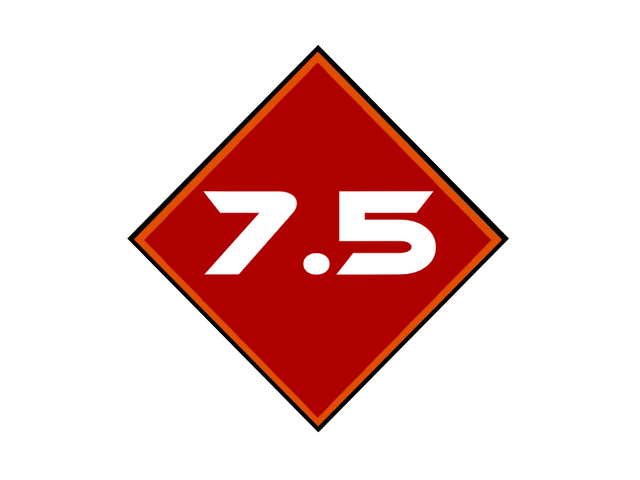Surviving Mars Review
It takes a long time to develop a game, as is well known. A new title is often given years of tinkering, which makes it difficult to respond to current events. That's why it's wise to use a theme that lasts longer than the development of a game takes. It's exactly what Haemimont Games has done. The Bulgarian studio in Surviving Mars is part of the dream of Elon Musk, who wants to send a manned mission to Mars with his SpaceX. If you follow these developments closely, then with Surviving Mars you can already experience the challenges that life on the red planet brings.
Surviving Mars looks like a management game, but is actually mainly a city builder. In the game you have to realise a flourishing and especially self-reliant colony on Mars from scratch, under the harsh climatic conditions prevailing there. This is no small challenge in itself, but you can also make it quite difficult for yourself.
𝐏𝐫𝐞𝐩𝐚𝐫𝐚𝐭𝐢𝐨𝐧
To stay in the Elon Musk-vibe, Surviving Mars begins on Earth. There you put together the mission that will build the first bridge to the red planet. You determine the content of the first rocket that flies to our neighborhood planet. You also determine how hard you want it to be. You can choose which sponsor supports the mission, and each sponsor has its own advantages and disadvantages. There are ten sponsors to choose from, divided into three categories: 'easy', 'average' and 'difficult'. Sponsors include powers such as Russia, China, the US and Europe, as well as institutions such as Church of the New Ark and the SpaceY company. The game advises you to choose the International Mars Mission as your sponsor for your first mission, and that's indeed advisable. The IMM is clearly the richest and provides the largest budget available. You will badly need that capital for the rockets you want to send to Mars during the game. The goal is to make your colony self-reliant on Mars, but every now and then some supply from Earth can do no harm, if only because your first rocket only contains cargo. People cannot walk around freely on Mars, so some preparations have to be made before the first settlers can walk around.
𝐋𝐚𝐧𝐝𝐢𝐧𝐠
There is another factor that has a big influence on the difficulty of the game. Once you have compiled the content of the first rocket, you can decide where it should land. You can choose any place on Mars. To help you with this, you get brief information about the landing places, for example how flat it is, what the average temperature is and how big the chance is of finding the necessary raw materials. The makers have highlighted about ten places that are already well known. In this way, you will know in advance more about the distribution of the raw materials you will encounter, and about the climatic conditions. With the information provided, you can, for example, foresee how great the chance is of extreme situations such as sandstorms and impacted meteorites.
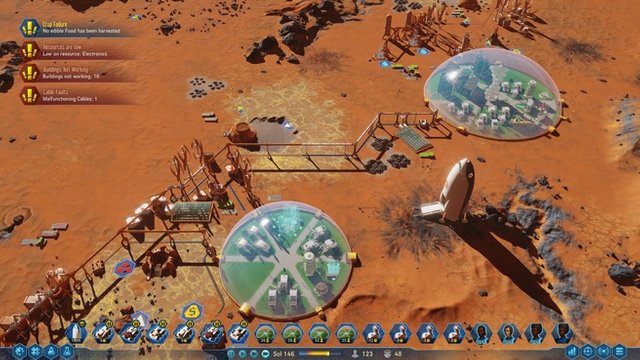
Once you've chosen a landing spot, the game really starts. From then on, you only get an isometric view of the planet's surface in the picture. Zooming out far is not possible, but zooming in far is. Haemimont has made a lot of work of detailing the game, and the studio wants to show that. If your colony is in order, you can literally follow each individual Mars resident closely, whether they work, eat or relax. That's fun and it looks good, especially because of the light-hearted graphic style Haemimont has chosen. The game looks a bit like Toy Story, especially if you zoom in, with the same color and retro style for the people and objects in the game.
𝐂𝐨𝐧𝐭𝐫𝐨𝐥 𝐫𝐨𝐛𝐨𝐭𝐬
Of course the game starts quite simple. Your spaceship contains some robots that you can steer, and with that you have to create the conditions for the first settlers to land. You have some building materials on board, but you will also have to find the necessary materials on Mars. Concrete, for example, to help realise the first buildings. The list of necessary ingredients soon becomes longer, although concrete, metal and water are the main minerals to grab. Which minerals you find somewhere determines where you place buildings. This includes the random part of the game around the corner. The landing spots Haemimont advises are always the same, but the ground conditions are different every time you play the game. There are approximately the same amounts of mineral resources in the soil, but the exact location of the veins varies. The zone where you land consists of a grid of 10 by 10 planes, of which only one has been explored in detail. Within that plane you know exactly where to find concrete, water and metal. The other 99 surfaces will need to be scanned first. It can take quite a long time before you have mapped out the entire zone. As a result, more and more opportunities can arise during the game, because surfaces constantly appear that are rich in mineral resources.
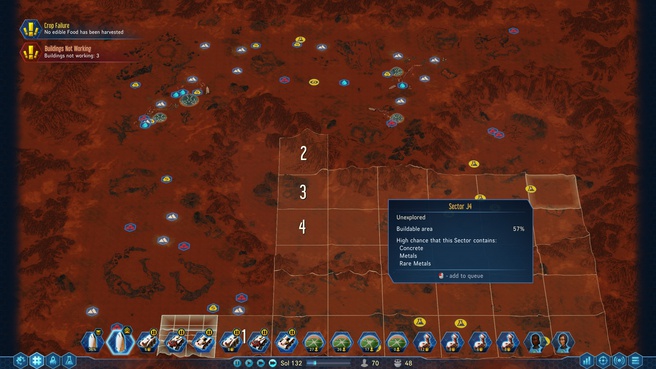
𝐂𝐨𝐧𝐜𝐫𝐞𝐭𝐞, 𝐞𝐥𝐞𝐜𝐭𝐫𝐢𝐜𝐢𝐭𝐲, 𝐰𝐚𝐭𝐞𝐫 𝐚𝐧𝐝 𝐨𝐱𝐲𝐠𝐞𝐧
When you've reached the point where you can extract concrete, electricity, water and oxygen from Mars, you're well on your way. After you have built a shelter, you can send the first settlers on their way. Then the game really starts and it becomes a matter of becoming self-sufficient. To achieve this, you need to produce more complex ingredients than just electricity, oxygen, water and concrete. For example, you need Polymers, Electronics and Machine Parts, from which the more complex constructions are constructed and maintained. You can also produce Fuel and mine Rare Metals.
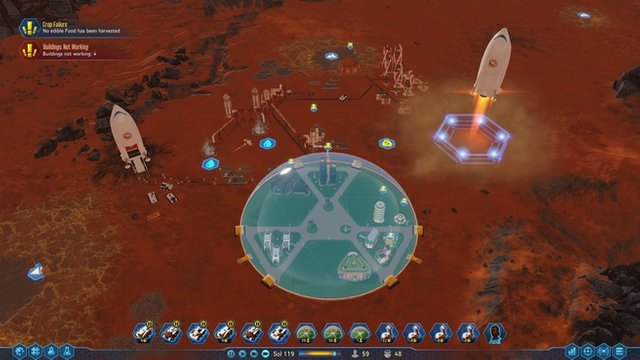
The latter product is interesting, and it plays a particularly important role if you want to make it difficult for yourself by choosing a sponsor who is less wealthy. Rare Metals are rare on Earth, and there is a great need for them. So you can sell them for good money and make some profit, which you can then use to get rockets with settlers or goods from Earth. If you have a less wealthy sponsor, the possibilities to have extra rockets sent are minimal and it is therefore useful to earn extra money in this way. If you opt for the International Mars Mission, you can make some headway with your initial capital.
𝐒𝐦𝐚𝐥𝐥 𝐝𝐢𝐟𝐟𝐞𝐫𝐞𝐧𝐜𝐞𝐬
Surviving Mars gradually develops into a game in which it's all about making small profits, growing slowly and becoming more effective. For example, you can have the factory where you manufacture Polymers produce 25 percent more, while using only 20 percent more power, to give a typical example. You can also choose to scale up in order to maximize the yield. It's all related to the research you can do. Surviving Mars has an extensive tech tree in which you can do research along lines such as Biotech, Engineering, Robotics and Social into new techniques, or into improving things you already mastered. It is striking that Haemimont has also built in a random element here. The techniques that you can explore are always the same, but the order in which this happens varies from one turn of play to the next. You can be unlucky or lucky, although the game is designed in such a way that everything that is essential is available outside the tech tree. You have to learn how to build the factories where you produce the necessary raw materials via the tech tree, but you can have ready-made prefabs sent from Earth.
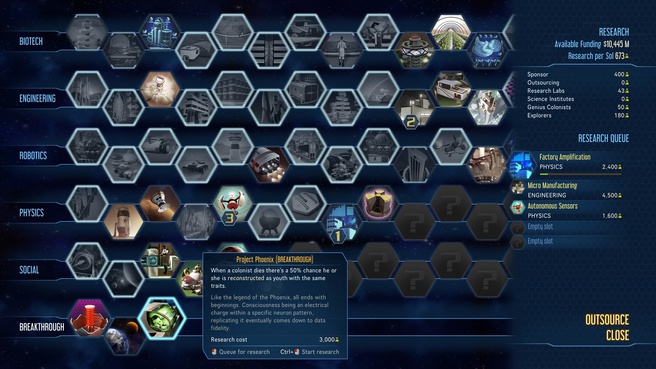
𝐓𝐡𝐢𝐧𝐤 𝐨𝐟 𝐲𝐨𝐮𝐫 𝐜𝐢𝐭𝐢𝐳𝐞𝐧𝐬
As in a real city builder, in Surviving Mars you will not only have to think about raw materials, but also about your subjects. The residents of your colony want to work for you, but only if they are a little happy. So you'll have to have fun. Moreover, you need qualified personnel. On Earth, you can recruit like that, but if you want to be self-sufficient, you have to provide young people. This can only be achieved if you build maternity clinics, schools and universities and if you also arrange staff for them. Moreover, you have to provide everyone with food, which again requires effort. There is a lot to manage.
That part of the game is fine, and for experienced players it offers a lot of details. Food is available in all sorts of varieties: from a generic type of food that nobody really likes to real Earth crops such as wheat and potatoes. To harvest such things, you need a full-fledged Farm that you build under the glass roof of a Domaine. The quality of the soil at such a Farm is poor, which can lead to crop failure. However, you do have some influence on that. If you grow potatoes, you get quick results and a lot of yield but the quality of the soil deteriorates. If you grow leafy vegetables, it takes a lot of time and the yield is low, but the soil quality improves. You can set a repeating order. If you do that intelligently, you build in such a variety of crops that the quality of the soil slowly improves and fewer harvests fail. Another example is selecting settlers that you can let go from Earth to Mars. With a Thumbs Up of Thumbs Down, you can specify preferences regarding aspects such as age, occupation and gender, and characteristics such as 'lazy', 'nagging' or 'gambler'. It indicates that there is a lot to do with micromanaging, especially the efforts of the many settlers you get in your care.
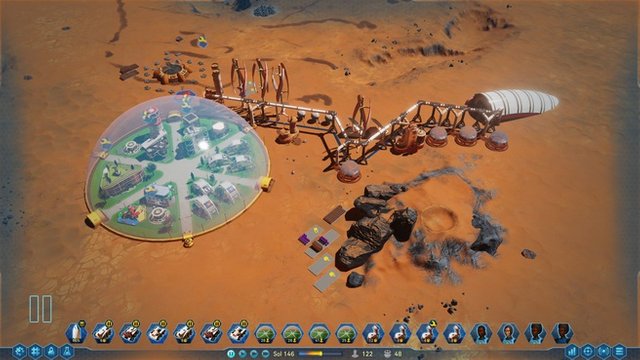
𝐌𝐢𝐥𝐞𝐬𝐭𝐨𝐧𝐞𝐬
Surviving Mars is above all a game in which you have to grow your business. Once you've built the first Domain for your settlers, more will follow and you'll be able to link to it. In doing so, you are building ever larger Domains. The disadvantage of Surviving Mars - and of most city builders - also emerges: there is not really a goal. Haemimont tries to overcome that a little by adding Milestones to the game. These are a kind of Achievements that you can reach, for example, with the first water you have won, with the first baby born into your colony, and so on. You get points for each Milestone, and once you have achieved all of them, you get a total score. However, there are no consequences for the late or non-existence of a Milestone. The list ends with the construction of your first Mega Dome and the construction of a first miracle.
Surviving Mars is not the game in which you can only build and grow indiscriminately. Stocks of water, concrete and metal are finite and not every source is equally rich. So it is important to think very carefully about the construction of the different parts of your colony. Where does the Domain come from and how do you let the pipes run? There's no quick grabbing and growing here.
Finally, there is a slightly mysterious side to Surviving Mars. There are some Mysteries in the game that can provide variety. There may be strange manifestations that you could investigate. However, it is also possible that at the same time there is a mission to the moon that is shy of raw materials, or an epidemic that threatens your colony. So you also have the horrors of Mars himself, which can cause some damage from time to time. None of this, however, has a major impact on your colony. It provides a little distraction, but not much. Surviving Mars is mainly a game in which you have to keep a colony running and grow very slowly.
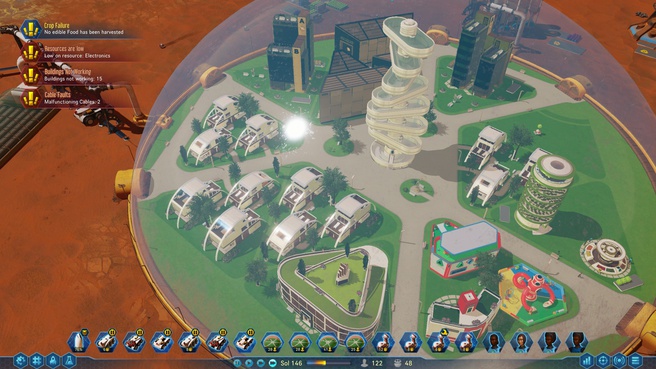
𝐞𝐯𝐞𝐫𝐲𝐭𝐡𝐢𝐧𝐠 𝐠𝐨𝐞𝐬 𝐰𝐫𝐨𝐧𝐠!
Of course, things can go wrong on the planet, which is part of a game like this. It can even easily go wrong in Surviving Mars, even if you think you've got your business in order. The game gives a neat overview of the resources you need, indicating how much you produce, how much your colony needs and how much of the various materials you have stored. Even if that overview is in order and all the lists are in the plus, things can quickly go wrong. That has to do with the fact that you have to do maintenance. Mars is a dusty world, so after a while everything is covered with a layer of grit, is broken and needs to be repaired. You soon learn that it is very disadvantageous to lay long pipes for electricity and water, because pipes often break down and require a lot of maintenance. So it is important to plan your base in such a way that the lines are short.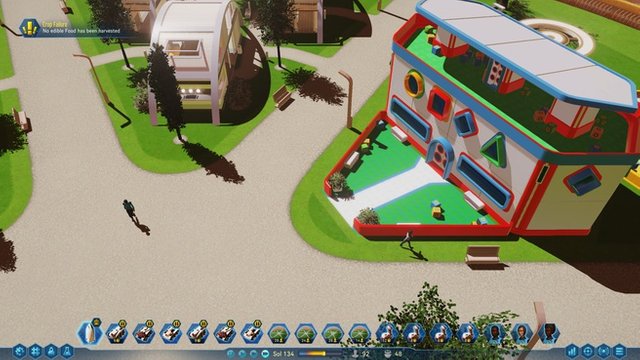
You have Drones who automatically carry out maintenance for you, but they do need raw materials to do their work. Moreover, they have to have those raw materials at hand, because if the right material is stored on the other side of your colony, things go wrong and a kind of chain reaction arises. For example, if a wind turbine crashes due to excess grit, your water pump may no longer get enough power, causing your Farm to produce insufficient food and causing the residents of one of your Domes to starve. The oxygen supply is particularly vulnerable, because your residents can only live without oxygen for a short period of time. If you have enough money, you can load a rocket on Earth full of raw materials and let it come across, but in many cases it will arrive too late.
𝐑𝐞𝐩𝐚𝐢𝐫 𝐢𝐭
Electronics, in particular, play an important role in this. This is one of the resources that you can manufacture on Mars in factories. It's a product you need to repair something here and there, for example other factories. Strangely enough, you also need Electronics to repair the electronics factory. It is of course difficult that you can no longer produce Electronics because your factory is broken, but you do need the same Electronics to fix the problem. It would have been nice if this had been better thought out and if the choice had been made to 'exchange' raw materials, so that you need Polymers to repair the electronics factory, for example, and Electronics to repair the Polymers factory.
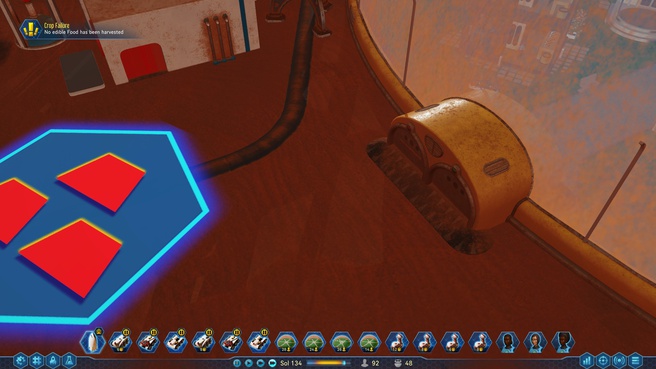
Another thing that doesn't help is that Haemimont gives very little explanation in the game. A tutorial is missing, and instead Hints are given and there is even a built-in Encyclopedia, but both are not very informative. Practical instructions are hardly to be found in it. Publisher Paradox Interactive has had five videos made that are very helpful and that are recommended via the game's Steam page, but the game itself doesn't make you much wiser.
Even more annoying is the fact that everything that can make the game fun and give it some extras is disconnected from the core of the game. You will be presented with challenges - research X within time Y - but whether you meet a challenge or not will not have any effect on gameplay. The same goes for the Mysteries and the very minimal storylines in the game. There is also little room for creativity. Every extension you build on the Mars surface has to comply with the same strict guidelines. You can specialize in the Domains a little, but you don't have any real freedom in it either. This is partly logical, given the theme of the game. After all, Mars is not a Theme Park and it's all about survival, but it doesn't make the game any more fun. Each time you replay the game, you will experience about a copy of the previous time. You can vary the difficulty and increase the challenge, but the gameplay always follows the same tight pattern. In Surviving Mars, there's no 'Out of the Dome' way of thinking, and that eventually breaks down the game.
𝐂𝐨𝐧𝐜𝐥𝐮𝐬𝐢𝐨𝐧
Surviving Mars is not a real survival game, but rather a real city builder with special challenges because it takes place on Mars. The Bulgarian developer Haemimont Games has delivered a beautiful simulator in which extracting raw materials, building a base, teaching, maintaining and entertaining Martian residents is quite a challenge. The challenge is big and you can increase it by choosing one of the different sponsors. It's also very easy for things to go wrong in Surviving Mars, and stock management and distribution are crucial. Those who love micro-management can indulge themselves in this. The makers also create a beautiful style that is depicted with a lot of detail.
Still, we have some reservations about the game. It's all a bit businesslike, maybe even a bit boring. There is challenge enough, but little surprise. Everything revolves almost exclusively around building a colony, otherwise the game offers almost nothing. There are some interim challenges and there are the Milestones, but they have so little impact on the game that they hardly distract from the goal. The Mysteries could have played that role, but they too play only a minor role. The fact that the tech tree is presented to you in random order is also a strange choice for the developers, although in practice it's a good thing to live with. Surviving Mars is all in all a good city builder, but a game that will only appeal to the true lover of that genre.
